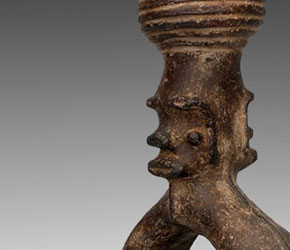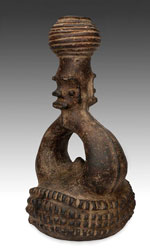Azande Medicine Pots
 |
|
The ethnic term
It is widely accepted the ancestors of the Azande migrated from the west into the present day Democratic Republic of the
 |
|
Nonetheless, the Azande practiced many traditional beliefs and customs well into the twentieth century. Azande typically believe that misfortune, death, the complications of life and the onset of disease are the result of mangu, or witchcraft. Azande medicine men are believed to have broad powers. They advise in all aspects of life including physical, psychological, spiritual, moral and legal matters as well as understand the significance of ancestral spirits and the reality of witchcraft.
The Azande medicine man is considered a magician. One Azande belief is that "vital force," the energy found in people, animals, trees, plants and inanimate objects, is neutral, neither good nor bad. While sorcerers and witches use this power for evil, medicine men use the same powers for good. Consequently, in Azande communities the medicine man was a focal figure of authority serving as diviner, prophet, healer and counselor. Called upon to fulfill his duties, he often used herbs and other ingredients to make potions which were dispensed through elaborate, figurative earthenware vessels.
Generally, there are three pottery types: (1) earthenware, (2) stoneware, and (3) porcelain. Each type is distinguished by its clay mixture and the temperature at which it fired. Earthenware is a clay mixture that is fired at a low temperature. Stoneware is made of a heavier clay mixture and fired at a much higher temperature. Porcelain is the heaviest, yet most delicate type of pottery. It is formed from white clay fired at a high temperature. Virtually all
Generally speaking, potters use two techniques to fabricate vessels: 1) large clumps of clay are scooped out and smoothed with the use of a flat instrument or by hand; or 2) coils of clay are rhythmically built up and then smoothed. Afterward, they may be decorated further by adding individual sculptural elements or incising. The Azande medicine vessels were created by technique one and then decorated further by adding elements such as the eyes and nubs on the surface.
Across the African continent, pottery is the work of specialized craftspeople; and among the majority of cultures, women are the potters. In some cases, they enjoyed special privileges; however, in most cultures potters are considered common craftspeople, despite being charged with creating objects to be be used for special purposes or important ceremonies. It would be impossible to say who made the
Download this Article: Azande Medicine Pots.pdf